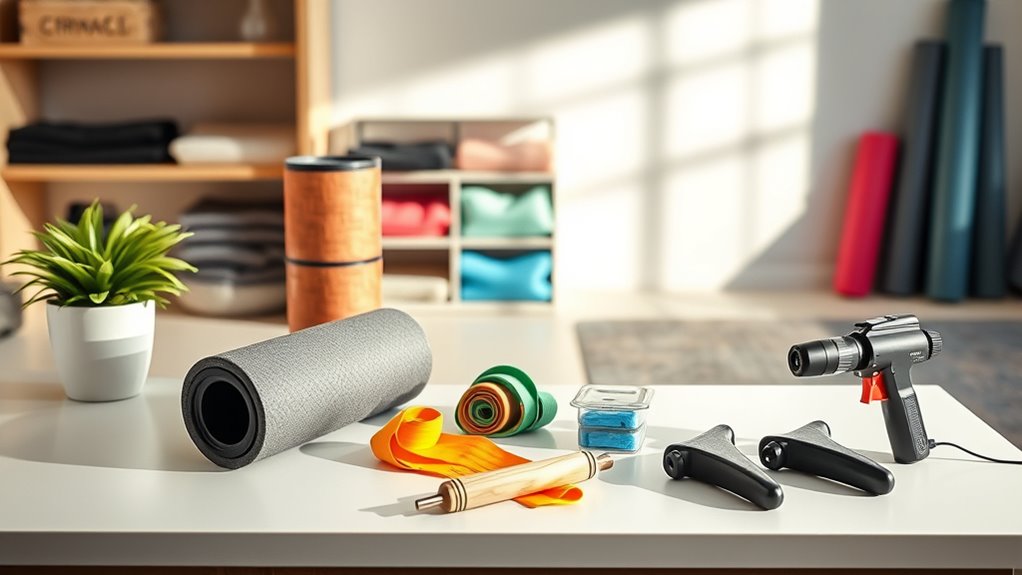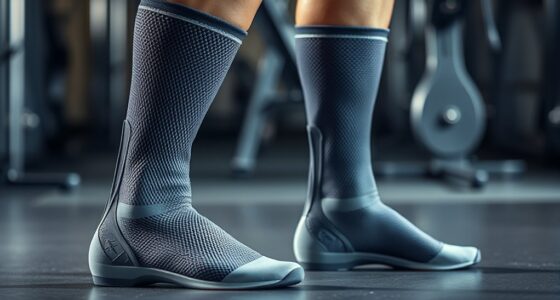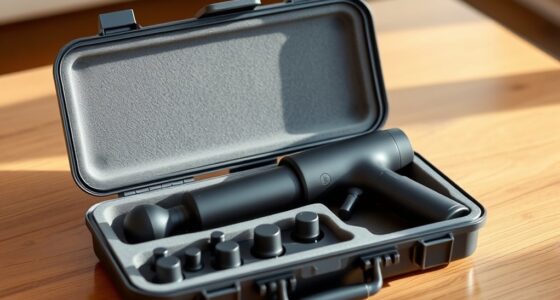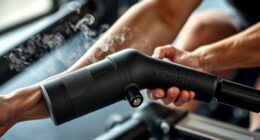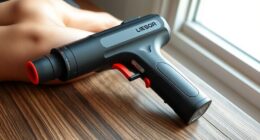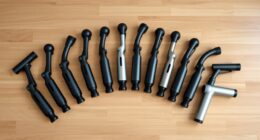To build your home recovery station, focus on tools that enhance mobility and support healing, like foam rollers, resistance bands, and small weights. Create a comfortable, organized space designed for regular use and easy access. Stock it with healthy snacks and hydration options to support nutrition. Include educational resources and tracking tools to stay motivated and monitor progress. Keep your space personalized and inspiring—stay tuned to discover more tips for creating a fully functional recovery zone.
Key Takeaways
- Incorporate foam rollers and resistance bands to enhance flexibility and mobility exercises beyond massage guns.
- Use small weights and balance tools to support strength training and functional movement routines.
- Establish a designated, clutter-free space that is easily accessible and inviting for consistent recovery practices.
- Stock the station with nutritious snacks, hydration options, and supplements to support tissue healing and energy replenishment.
- Utilize visual guides, tracking journals, or digital apps to monitor progress, motivate, and personalize your recovery plan.
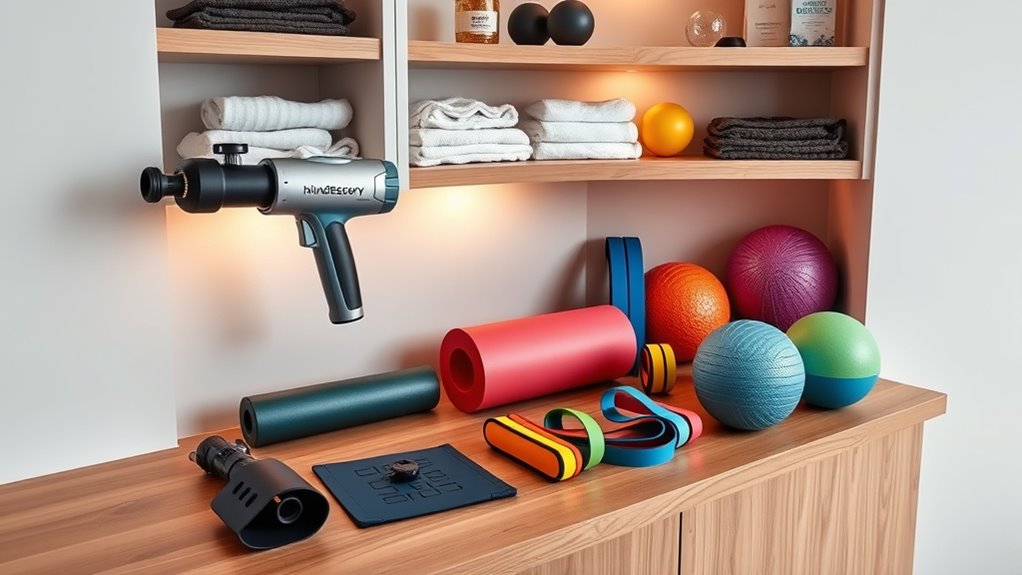
Ever wondered how to create a dedicated space at home that helps you recover faster and feel more in control of your health? Building your home recovery station isn’t just about stacking up equipment; it’s about designing a space that encourages consistent self-care. One of the most effective ways to do this is by integrating tools and routines that support mobility exercises and nutritional strategies. When you prioritize these elements, you’ll find yourself more motivated and better equipped to handle recovery on your terms.
Start by setting aside a clear, organized area that’s free from clutter. This space should be welcoming and functional, allowing you to perform mobility exercises comfortably. These exercises are vital for restoring flexibility, improving circulation, and reducing stiffness after injury or intense training. Incorporate items like foam rollers, resistance bands, or small weights, which are versatile and easy to use. As you perform these mobility exercises regularly, you’ll notice increased range of motion and decreased discomfort, making your recovery more efficient. Remember, consistency is key, so design your space to make it easy to stick with your routine.
Create an organized, clutter-free space with foam rollers and resistance bands for effective mobility exercises.
Beyond physical tools, focus on the nutritional strategies that support your recovery. Stock your recovery station with healthy snacks, hydration options, and supplements if recommended by a healthcare professional. Proper nutrition fuels your body’s healing process and can reduce inflammation. Consider keeping a water bottle nearby to stay hydrated, along with nutrient-dense foods like nuts, fruits, or protein shakes. If you’re working on specific health goals, supplement your diet with vitamins or minerals that promote tissue repair and immune support. Creating a dedicated spot for your nutritional needs guarantees you’re always reminded to nourish your body properly, which accelerates healing and improves overall wellness.
In addition, incorporate educational resources like charts, books, or digital apps that guide your mobility exercises and nutritional plans. Visual cues and accessible information help keep you committed and informed about your recovery journey. You might also include a journal or planner to track your progress, noting improvements in mobility and changes in your diet. This accountability can make a significant difference in maintaining your routines and celebrating your milestones.
Furthermore, understanding the importance of creative storytelling can motivate you to personalize your recovery space, making it more engaging and inspiring. Ultimately, your home recovery station should be a personalized refuge that encourages active participation in your healing process. By combining the right tools for mobility exercises with strategic nutritional planning, you’ll create a powerful environment that promotes faster recovery, better health, and a sense of control. Remember, building this space is an investment in your well-being, turning everyday routines into empowering habits that support your long-term health goals.
Frequently Asked Questions
What Are the Best Storage Solutions for Recovery Tools?
When choosing storage solutions for your recovery tools, focus on storage organization that keeps everything tidy and accessible. Use clear bins or drawers to separate different equipment types, making it easy to find what you need quickly. Incorporate equipment labeling to keep items properly identified, preventing mix-ups. Consider wall-mounted racks or shelves for space-saving and visibility, ensuring your recovery tools are well-organized and ready whenever you need them.
How Do I Choose the Right Recovery Equipment for My Needs?
Deciding on the right recovery equipment depends on your specific needs. Focus on factors like flexibility, intensity, and target areas. Foam rollers are great for deep tissue work, while massage sticks offer pinpoint pressure. Consider your comfort level, budget, and goals. Try different tools to see what suits your body best. Remember, choosing versatile, high-quality gear guarantees effective recovery and helps you stay consistent in your routine.
Are There Safety Precautions for Using Recovery Tools at Home?
When using recovery tools at home, it’s vital to follow safety guidelines to prevent injury. Always read the manufacturer’s instructions carefully, start with gentle settings, and avoid overusing devices on one area. Keep your tools clean and inspect them regularly for damage. If you feel pain or discomfort, stop immediately. By adhering to these safety precautions, you can enjoy effective recovery sessions while minimizing injury risks.
What Budget-Friendly Options Exist for Building a Recovery Station?
Think of creating your recovery station as planting a garden—you need the right tools without breaking the bank. Affordable alternatives like foam rollers, resistance bands, and tennis balls serve as your DIY recovery gear, helping you nurture your body back to health. You can find these budget-friendly options at local stores or online, transforming your space into a sanctuary of self-care without draining your wallet.
How Can I Personalize My Home Recovery Setup Effectively?
You can personalize your recovery setup by customizing your routines to target your specific needs, like incorporating foam rollers or resistance bands. Focus on creating an ergonomic setup with comfortable mats and adjustable tools to prevent strain. Add personal touches such as relaxing lighting, soothing music, or favorite scents to enhance your experience. This way, your recovery station becomes a reflection of your preferences, making it more effective and enjoyable.
Conclusion
Creating your home recovery station sets you up for success, giving you the tools to stay healthy and recover faster. Remember, a well-prepared home is a happy home—invest in the essentials, and you’ll feel the difference. Stay consistent, and don’t forget, Rome wasn’t built in a day. With patience and the right tools, you’ll turn your space into a sanctuary of wellness, making recovery an enjoyable part of your daily routine.
